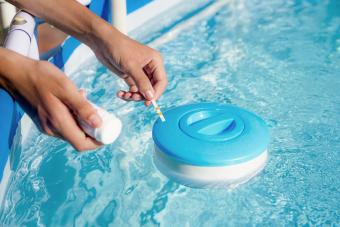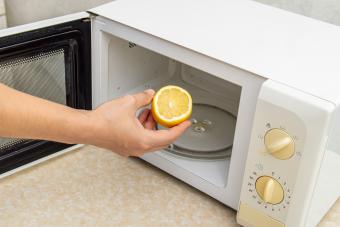
Did you uncover your pool only to find it a rather embarrassing shade of green? Don't worry; getting your pool back to blue can be done in a few steps. You'll also learn how to clean a green pool and how to maintain it to keep it from going green again.
How to Clean a Green Pool With the SLAM Method
Nobody wants to swim in a green pool! But why is your pool green? If you guessed algae, you are right. When your chlorine levels get too low, algae can grow and turn your water green. Depending on how long you let it go, you could get frogs and tadpoles too. Yuck! Thankfully, you can get your pool back to that beautiful blue with a few steps. Professional pool cleaners refer to these steps as the SLAM (shock level and maintain) method. Learn the SLAM method. It can help you clean your pool with a few simple supplies.
- FAS-DPD test kit
- Skimmer pole, net, pool, vacuum
- Muriatic acid
- Soda ash
- Shock treatment (chlorine)
- Cyanuric acid
- Protective gear
Step 1: Remove Large Debris
You want to work with water as clean as you can get it. So, your first step is to remove as much organic material as possible.

- Use the net to skim the surface.
- Brush the bottom and sides of the pool.
- Use the net to catch the organic material you kicked up.
- Once all the large stuff is gone, use the vacuum to get any remaining organic matter.
Step 2: Test Your Water Chemistry
Once all the gunk is out of the water, it's essential to test your water chemistry. You'll want to look specifically at the free chlorine, pH level, and cyanuric acid (CYA).

- Test the chemistry of the water.
- The pH level should be between 7.5 and 7.8.
- The CYA should be between 30-60 ppm.
- Free chlorine should be between 3-7 ppm.
- Apply the appropriate chemicals (muriatic acid, soda ash, cyanuric acid, etc.) to rebalance your chemistry.
You can use a pool chemistry calculator to help you figure out the best dosages to rebalance your pool. Additionally, when working with chemicals wear protective gear like gloves and goggles.
Step 3: Shock Your Pool
Now it's time to add high levels of chlorine to your pool to kill the algae. Testing the chemistry was vital because you need to use the CYA level to determine how much chlorine you need to add to your pool. You can do this on the free pool calculator. For example, if your CYA was 60, you need to reach free chlorine of 24 when you shock the pool. Once you know how much to add, follow these steps.

- Add the shock treatment to your pool per the recommended dosages.
- Allow your pump to run for 24 hours.
- Test your pool every few hours.
- Add more shock as needed to maintain your shock level.
- As your shock levels start maintaining, you can check your water less often.
Do not get in your pool while you are completing the SLAM method due to the high chlorine levels in the water.
Step 5: Clean Filter
Continuously clean your filter to remove the algae it has pulled from the pool. Cleaning your filter ensures it's running at tip-top shape to pull all that algae and grime out. You should let your filter run continuously for the first 24 hours, but it would be best to let it run for the entirety of the process.
Step 6: Vacuum and Scrub Pool
As the SLAM method starts to kick into high gear, you'll notice your pool will become cloudy. Keep cleaning out your filter. Add vacuuming and scrubbing to the mix to get those dead algae out of there.
- Use the skimmer and brush to remove clumps and brush the sides of the pool.
- Vacuum out the pool to get any debris on the bottom.
- Continue cleaning the filter and vacuuming until the pool becomes clear.
Step 7: Complete a Chlorine Loss Test
Once your pool is a lovely clear blue, you want to run a chlorine loss test.
- Test your free chlorine level at dusk.
- At dawn, test again.
- To pass, free chlorine shouldn't drop less than 1 ppm. Additionally, your combined chlorine should be less than .5.
- If it dropped more than the levels above, you need to keep doing the SLAM process and test again the next day.
How Long Does It Take for Green Pool to Clear Up?
When your pool has gone green, you will start noticing a difference in the first 24 hours. If you caught it early, it might be ready for swimming in a day or two. However, it typically takes anywhere from 4-5 days for a pool to be utterly free from algae.

How to Maintain Your Pool to Avoid Green Water
Now that you've gotten your pool back to blue, you don't want to do that again. It's a long and arduous process of shocking and testing. To keep your pool fresh and clean, there are a few things you can do.
- Vacuum your pool weekly.
- Brush the sides of your pool.
- Swim regularly in your pool to keep the water moving.
- Test your pH, free chlorine, and CYA levels weekly.
- Add chemicals as needed.
- Clean the skimmer regularly.
- Check filter and backwash as you need to.
- Run your filter at least 10-12 hours a day.
How to Clean a Green Pool Fast
Cleaning a green pool takes work. But if you hop on the problem fast before you have a full-on algae bloom, you can clean your pool in a day or two. Keep your pool safe and healthy this swimming season.







